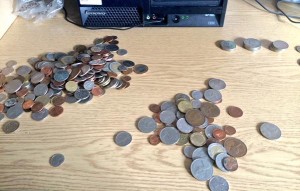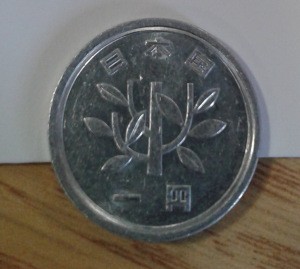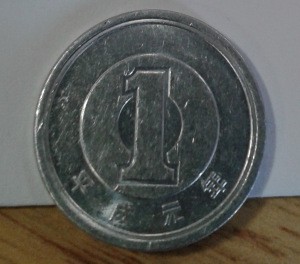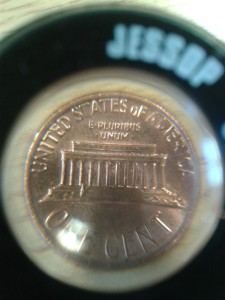A trip around the World
On 1st April I was given a chance to take a break from my German pfennigs. The Harris Museum, like most public centres, has a donation box. This is for visitors to make cash donations towards the museum. Either visitors misunderstood and thought it was for donations towards the coin collection, or they just wanted to leave their mark. The Harris staff had emptied the donation box and found over 200 foreign coins! Korean, Russian, Spanish, Greek, Swedish, Gibraltar, Falklands, Canada, the US and so many more.
Some of the foreign coins donated to the Harris (photo courtesy of Matt Ball)
I like to think that these coins show where the visitors to the Harris come from, because that would be amazing. So that Wednesday, I helped Matt – the Money Matters project curator – catalogue half of them. This definitely made for a nice break from the German pfennigs. There were so many interesting coins! Below is one of my favourites. Japanese yen coin This coin is from Japan. Now, I do think the branch is quite a pretty design but that isn’t the reason why I like this coin.
 Sprouting branch on Japanese 1 yen coin
Sprouting branch on Japanese 1 yen coin
I really like this coin because of the four Japanese symbols on the other side of the coin.
Those four symbols are very interesting. You would assume – as Matt and I did at first – that each one is a number and so it says the date. You would be half right. It does say the date. But Japanese coins do not follow the same western Gregorian calendar that Britain does. Instead, the Japanese calendar is divided into ‘eras’, which is why it is called the Japanese era calendar, or Nengo (Reign Era). These eras start and end with the birth and death of the Japanese emperor. To read the date on modern Japanese coins, you have to identify the first two symbols to an emperor. The two on our coin read 平成, which means Heisei. This is the era corresponding to the current reigning Japanese emperor Akihito. The third symbol is a number. This number identifies what year, within that particular era, the coin was made. Our coin bears this symbol: 
This confused us for a while because it doesn’t correspond to any of the Japanese symbols for numbers. However, it is actually the symbol for ‘Gan’, which on coins essentially means ‘1’ or ‘First’.
The fourth and final symbol is quite simple. 
It means ‘year’. All of this means that this coin was made in the first year of Emperor Akihito’s reign, which was… *drumroll* … 1989! You have no idea how proud I felt after finally figuring that out. If you want to learn more about Japanese coins or the era calendar, the websites below are very useful:
- http://www.lioncoins.com/nippon.htm
- http://portlandcoins.blogspot.co.uk/2012/11/reading-japanese-numbers-and-dates.html
- http://en.wikipedia.org/wiki/Heisei_period
And finally, this coin is an US 1 cent, through a small hand held magnifying lens.

